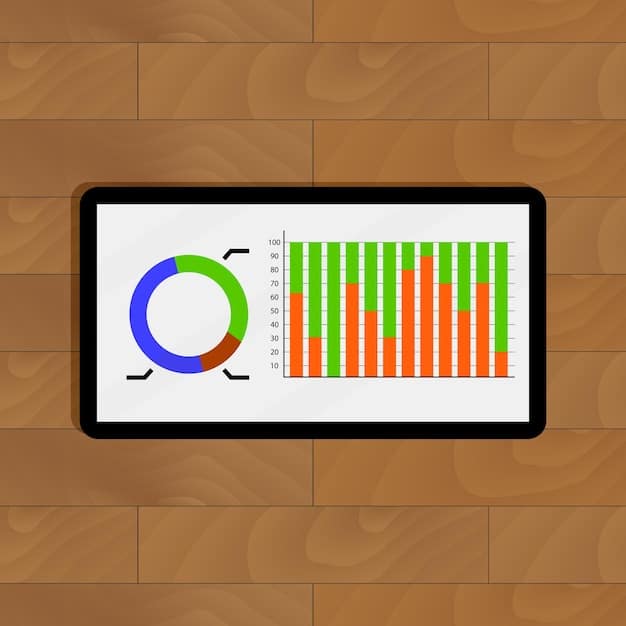E-commerce Platform Performance: Tips to Reduce US Page Load Time by 50%

E-commerce Platform Performance: By optimizing images, leveraging browser caching, minimizing HTTP requests, using a Content Delivery Network (CDN), and choosing a fast hosting provider, e-commerce platforms can reduce their US page load time by 50%, improving user experience and boosting sales.
Is your e-commerce site struggling with slow loading times in the US? You’re not alone! Slow page load times can kill conversions and frustrate customers. But don’t despair, improving E-commerce Platform Performance: Reduce Your US Page Load Time by 50% with These Optimization Tips is within reach. This guide will provide actionable strategies to dramatically improve your website’s speed, enhance user experience, and ultimately boost your bottom line.
Understanding the Impact of Page Load Time on E-commerce Success
Page load time is critical for e-commerce success. In today’s fast-paced digital world, users expect websites to load quickly and efficiently. A slow-loading website can lead to frustrated customers, abandoned shopping carts, and a significant loss in revenue.
Studies have consistently shown that even a slight delay in page load time can negatively impact key metrics such as bounce rate, conversion rate, and customer satisfaction. For example, a one-second delay can result in a 7% reduction in conversions. Understanding these impacts can motivate you to implement changes to Improve E-commerce Platform Performance: Reduce Your US Page Load Time by 50% with These Optimization Tips
The Direct Correlation Between Speed and Conversions
Faster websites translate directly into higher conversion rates. When pages load quickly, users are more likely to browse products, add items to their cart, and complete the checkout process. A seamless and speedy experience encourages customers to stay on the site and make purchases.
- A one-second improvement in mobile page speed can increase conversions by up to 27%.
- E-commerce sites with faster loading times often see higher average order values.
- Reduced bounce rates mean more potential customers stay engaged with your content.
Customer Expectations and Brand Perception
In the competitive e-commerce landscape, customer expectations are constantly rising. Users demand a smooth and responsive experience, and they are quick to abandon websites that fail to meet these expectations. Slow loading times can tarnish your brand’s image and lead to poor customer reviews.

A fast website demonstrates that you value your customers’ time and are committed to providing a positive shopping experience. This can lead to increased customer loyalty and positive word-of-mouth referrals.
In conclusion, optimizing page load time is an essential investment for any e-commerce business looking to enhance customer satisfaction, increase conversions, and maintain a competitive edge in the market. Focusing efforts to improve E-commerce Platform Performance: Reduce Your US Page Load Time by 50% with These Optimization Tips, will surely help reach your goals.
Image Optimization Techniques for Faster Loading Times
Images often constitute a significant portion of a website’s total page size. Optimizing images is crucial for reducing page load time and improving overall site performance. By using the right image formats, compressing images, and implementing lazy loading, you can significantly reduce the impact of images on your site’s speed
By optimizing images, you can ensure that your website loads quickly without sacrificing visual quality. These practices directly influence efforts to improve E-commerce Platform Performance: Reduce Your US Page Load Time by 50% with These Optimization Tips
Choosing the Right Image Formats
Selecting the appropriate image format is essential for balancing image quality and file size. Different formats are suited for different types of images, and using the wrong format can lead to unnecessarily large file sizes. For e-commerce sites, the most commonly used formats are JPEG, PNG, and WebP.
- JPEG: Ideal for photographs and complex images with many colors. JPEGs use lossy compression, which reduces file size but can also reduce image quality.
- PNG: Best for images with text, logos, and graphics with sharp lines and few colors. PNGs use lossless compression, which preserves image quality but can result in larger file sizes.
- WebP: A modern image format developed by Google that offers superior compression and image quality compared to JPEG and PNG. WebP supports both lossy and lossless compression.
Compressing Images Without Losing Quality
Image compression reduces the file size of images without significantly impacting their visual quality. There are several tools and techniques available for compressing images, including online image optimizers, desktop software, and Content Management System (CMS) plugins.

When compressing images, it’s essential to strike a balance between file size and image quality. Over-compressing images can result in visible artifacts and a loss of detail, while under-compressing images may not significantly reduce file size. Using tools like TinyPNG or ImageOptim can help automate the compression process while preserving image quality.
In summary, investing time in image optimization is a high-impact strategy for improving page load time and enhancing the overall performance of your e-commerce website. Image optimization is an easy implementation to improve E-commerce Platform Performance: Reduce Your US Page Load Time by 50% with These Optimization Tips.
Leveraging Browser Caching for Repeat Visitors
Browser caching is a technique that stores static resources, such as images, CSS files, and JavaScript files, on a user’s computer. When a user revisits your website, the browser can retrieve these resources from the local cache instead of downloading them again from the server. This can significantly reduce page load time for repeat visitors.
Browser caching is an effective way to improve website performance, especially for users who frequently visit your site. This simple change can vastly improve E-commerce Platform Performance: Reduce Your US Page Load Time by 50% with These Optimization Tips
How Browser Caching Works
When a user visits a webpage, the server sends HTTP headers that instruct the browser how long to cache specific resources. These headers include information such as the cache-control directive and the expires directive. The cache-control directive specifies the maximum amount of time that a resource can be cached, while the expires directive specifies a specific date and time when the resource should be considered stale.
When a user revisits the webpage, the browser checks its cache to see if the requested resources are available. If the resources are found in the cache and are not stale, the browser retrieves them from the cache instead of downloading them from the server. This reduces the amount of data that needs to be transferred over the network and speeds up page load time.
Configuring Browser Caching
Browser caching can be configured at the server level or through a Content Delivery Network (CDN). At the server level, you can configure caching by modifying your web server’s configuration file, such as the .htaccess file for Apache servers. This involves setting appropriate cache-control and expires headers for static resources.
For example, to cache images for one week, you can add the following code to your .htaccess file:
<FilesMatch "\.(ico|jpg|jpeg|png|gif|svg)$">
<IfModule mod_expires.c>
ExpiresActive On
ExpiresDefault "access plus 1 week"
</IfModule>
</FilesMatch>
To leverage browser caching without touching underlying files, you can turn to using a CDN.
Overall, implementing browser caching is a simple yet powerful technique that can significantly improve website performance and user experience. By properly configuring caching headers for static resources, you can reduce page load time for repeat visitors and create a faster, more responsive e-commerce platform.
Minimizing HTTP Requests to Reduce Server Load
Each element on a webpage, such as images, CSS files, and JavaScript files, requires a separate HTTP request to be downloaded from the server. Minimizing the number of HTTP requests can significantly reduce page load time by reducing the overhead associated with establishing connections and transferring data.
Reducing the number of HTTP requests your site makes can provide a significant boost when seeking to improve E-commerce Platform Performance: Reduce Your US Page Load Time by 50% with These Optimization Tips.
Combining CSS and JavaScript Files
One way to minimize HTTP requests is to combine multiple CSS and JavaScript files into single files. This reduces the number of requests required to download these resources and can significantly improve page load time. There are several tools and techniques available for combining CSS and JavaScript files, including online file combiners, build tools, and CMS plugins.
When combining CSS and JavaScript files, it’s essential to ensure that the combined files are properly minified to reduce their file size. Minification removes unnecessary characters, such as whitespace and comments, from the code, which can further reduce page load time.
Using CSS Sprites for Images
CSS sprites combine multiple small images into a single larger image. This reduces the number of HTTP requests required to download these images and can significantly improve page load time. CSS sprites use CSS background-position to display individual images from the sprite.
- Reduces server load by minimizing the number of image requests.
- Improves page load time by reducing the overhead associated with establishing connections.
- Simplifies image management by consolidating multiple images into a single file.
Inline Critical CSS
A way to minimize HTTP requests is to utilize inlined critical CSS. Critical CSS is the minimal amount of CSS required to render the above-the-fold content of your website. Above-the-fold content is what the user sees before scrolling, so prioritizing its rapid display is essential.
By inlining critical CSS directly into the HTML of your pages, you eliminate the need for an additional HTTP request to fetch an external CSS file. This technique can significantly reduce the initial render time, providing a faster and more responsive user experience.
Reducing HTTP requests is a critical optimization strategy for e-commerce platforms seeking faster load times. By combining files, using CSS sprites, inlining critical CSS, and optimizing images, you can significantly reduce the number of requests and improve overall site performance.
Utilizing a Content Delivery Network (CDN) for Faster Content Delivery
A Content Delivery Network (CDN) is a network of servers located in multiple geographic locations. When a user visits your website, the CDN delivers content from the server that is closest to the user, which can significantly reduce page load time, especially for users who are located far away from your primary server.
To improve E-commerce Platform Performance: Reduce Your US Page Load Time by 50% with These Optimization Tips, CDNs should be strongly considered.
How CDNs Work
When you use a CDN, your website’s static resources, such as images, CSS files, and JavaScript files, are stored on multiple servers across the CDN’s network. When a user visits your website, the CDN automatically directs the user to the server that is closest to their location.
This reduces the distance that data needs to travel, which can significantly reduce latency and improve page load time. CDNs also offer other benefits, such as increased reliability, scalability, and security.
Choosing the Right CDN Provider
There are several CDN providers available, each with different features, pricing plans, and network coverage. When choosing a CDN provider, it’s essential to consider your specific needs and requirements. Some popular CDN providers include:
- Cloudflare
- Akamai
- Amazon CloudFront
- MaxCDN (StackPath)
When selecting a CDN provider, consider factors such as network coverage, pricing, features, and customer support. Some CDN providers offer free plans for small websites, while others offer more advanced features and pricing plans for larger e-commerce platforms.
Implementing and Configuring a CDN
Implementing a CDN typically involves signing up for a CDN account, configuring your website to use the CDN, and uploading your static resources to the CDN’s servers. Most CDN providers offer detailed instructions and support for implementing and configuring their services.
Once you have configured your website to use the CDN, the CDN will automatically deliver content from the server that is closest to the user. You can also configure the CDN to cache your website’s content, which can further improve page load time for repeat visitors.
Implementing a CDN is a valuable investment for any e-commerce business looking to reduce page load time, improve user experience, and enhance overall website performance. By delivering content from servers located closer to users, CDNs can significantly reduce latency and improve site speed.
Optimizing Your E-commerce Platform’s Code
The performance of your e-commerce platform’s code is a pivotal factor in determining page load times and overall user experience. Inefficient or bloated code can lead to slow loading speeds, which can deter customers and negatively affect conversion rates.
Improving efficiencies in your websites code and development can provide improvements to E-commerce Platform Performance: Reduce Your US Page Load Time by 50% with These Optimization Tips.
Minifying HTML, CSS, and JavaScript
Minification involves removing unnecessary characters, such as whitespace, comments, and line breaks, from your code. This process reduces the file size of your HTML, CSS, and JavaScript files, which can significantly improve page load time. Minification tools are widely available online and can be easily integrated into your development workflow.
Minification is a simple yet effective technique that can yield significant performance gains. By reducing the size of your code files, you can decrease the amount of data that needs to be transferred over the network, resulting in faster page load times.
Deferring Loading of Non-Critical Resources
Not all resources are essential for rendering the initial view of your webpage. Deferring the loading of non-critical resources, such as images, scripts, and iframes, can prevent them from blocking the rendering process and improve perceived performance.
Implementing lazy loading for images and iframes is an effective way to defer their loading until they are visible in the viewport. Similarly, you can use the “async” or “defer” attributes when including JavaScript files to prevent them from blocking the parsing of the HTML document.
Database Optimization
Many e-commerce platforms rely on databases to store product information, customer data, and other essential content. Optimizing your database can significantly improve query performance and reduce page load time.
Regularly optimize your database by removing unnecessary data, indexing frequently queried columns, and using caching techniques to store frequently accessed data in memory. Properly optimized databases are very important when seeking to improve E-commerce Platform Performance: Reduce Your US Page Load Time by 50% with These Optimization Tips.
Prioritizing code optimization can lead to a faster, more responsive e-commerce platform that enhances user engagement and drives conversions. Whether it’s minifying code, deferring loading, or optimizing databases, these steps collectively contribute to an enhanced online shopping experience.
Choosing a Fast and Reliable Hosting Provider
The hosting provider you choose plays a critical role in determining your e-commerce platform’s performance. A fast and reliable hosting provider can ensure that your website is always available and that pages load quickly. Conversely, a slow or unreliable hosting provider can lead to downtime, slow loading times, and a poor user experience.
If you want to take strides to improve E-commerce Platform Performance: Reduce Your US Page Load Time by 50% with These Optimization Tips, you must select an appropriate hosting provider.
Types of Hosting Options
There are several types of hosting options available, each with different features, pricing plans, and performance characteristics. Some common hosting options include:
- Shared Hosting: Multiple websites share the same server resources. This is the most affordable hosting option, but it can also be the slowest and least reliable.
- Virtual Private Server (VPS) Hosting: A single server is divided into multiple virtual servers, each with its own dedicated resources. This offers better performance and reliability than shared hosting.
- Dedicated Hosting: You have exclusive access to an entire server. This is the most expensive hosting option, but it offers the best performance and control.
- Cloud Hosting: Your website is hosted on a network of virtual servers, which allows for scalability and high availability.
Factors to Consider When Choosing a Hosting Provider
When choosing a hosting provider, consider factors such as:
Performance: Look for a hosting provider that offers fast servers, solid-state drives (SSDs), and optimized caching.
Reliability: Choose a hosting provider with a proven track record of uptime.
Support: Select a hosting provider that offers responsive and helpful customer support.
Pricing: Compare pricing plans from different hosting providers to find one that fits your budget.
Monitoring Website Performance
Once you have chosen a hosting provider, it’s essential to monitor your website’s performance regularly to identify and address any issues that may arise. There are several tools and techniques available for monitoring website performance, including:
Website speed testing tools: These tools measure your website’s page load time and identify areas for improvement.
Server monitoring tools: These tools monitor your server’s resources, such as CPU usage, memory usage, and disk I/O.
Uptime monitoring tools: These tools monitor your website’s uptime and notify you if your website goes down.
Regularly assessing your website’s performance using these tools allows you to ensure your work to imporve E-commerce Platform Performance: Reduce Your US Page Load Time by 50% with These Optimization Tips goes as planned.
| Key Point | Brief Description |
|---|---|
| 🖼️ Image Optimization | Compress images and use appropriate formats (JPEG, PNG, WebP). |
| 🌐 Browser Caching | Enable browser caching to store static resources for repeat visitors. |
| 🚀 CDN Usage | Implement a Content Delivery Network to deliver content from servers closest to users. |
| ⚙️ Code Optimization | Minify code, defer loading, and optimize the database for peak efficiency. |
Frequently Asked Questions
▼
Faster page load times improve user experience, reduce bounce rates, and increase conversion rates. Customers are more likely to complete purchases on fast-loading sites. Slow sites frustrate users, leading to abandoned carts and lost sales.
▼
Use JPEG for photographs with many colors, PNG for graphics with sharp lines and text, and WebP for superior compression and quality. WebP offers both lossy and lossless compression, making it a versatile option for various image types.
▼
Browser caching stores static resources on a user’s computer, allowing faster retrieval upon revisits. This reduces server load and accelerates page load times for repeat visitors, improving overall site performance and user experience.
▼
A CDN distributes your site’s content across multiple servers globally, delivering content from the server closest to each user. This reduces latency, improves load times, and enhances the overall user experience, especially for international customers.
▼
Optimized code reduces file sizes, improves rendering speed, and enhances overall site performance. Minifying code, deferring loading, and optimizing databases contribute to a faster, more responsive e-commerce platform, leading to higher conversion rates.
Conclusion
Optimizing your e-commerce platform’s performance in the US is crucial for success. By implementing these optimization tips, including image optimization, leveraging browser caching, minimizing HTTP requests, utilizing a CDN, and choosing a fast hosting provider, you can significantly reduce page load time, improve user experience, and boost sales. Prioritize these strategies to stay competitive in the fast-paced e-commerce landscape.





